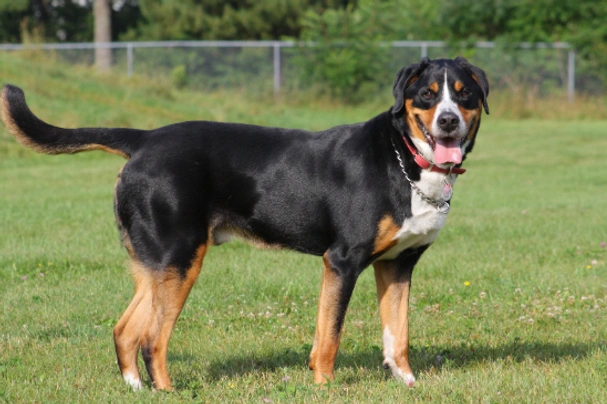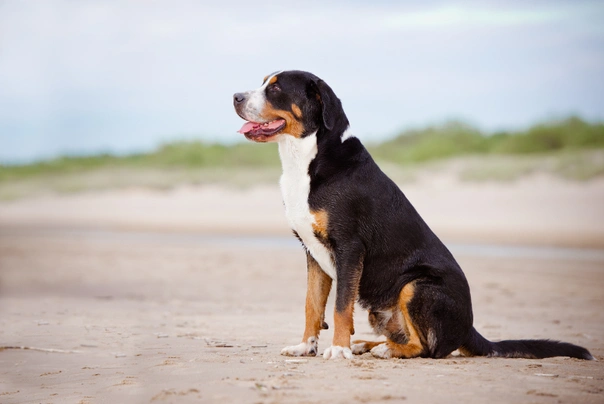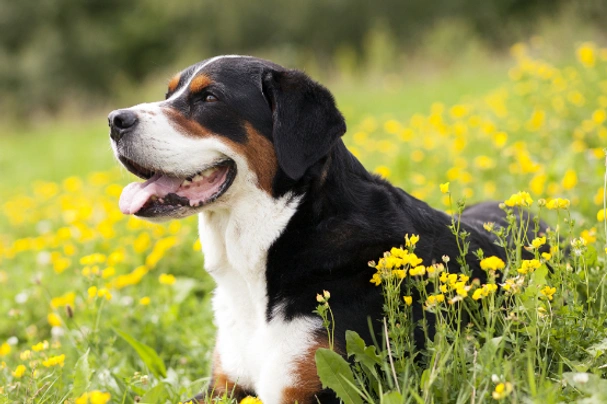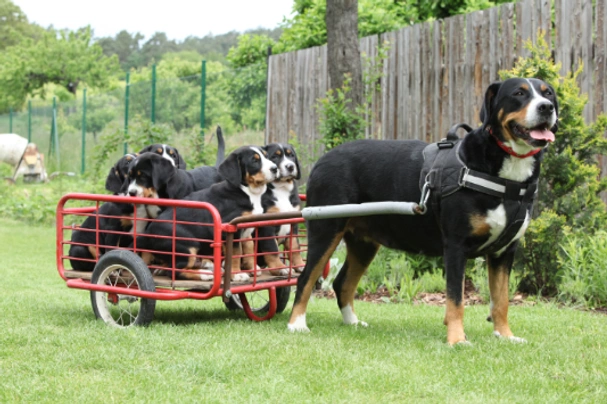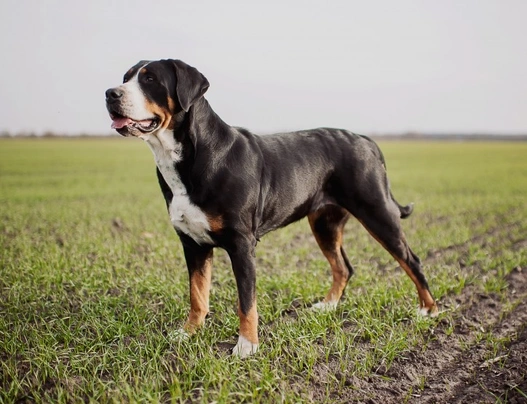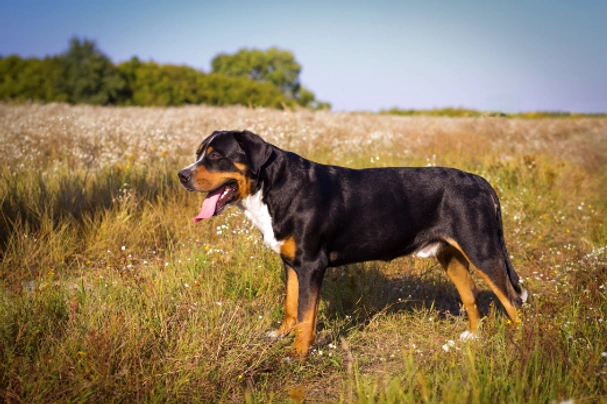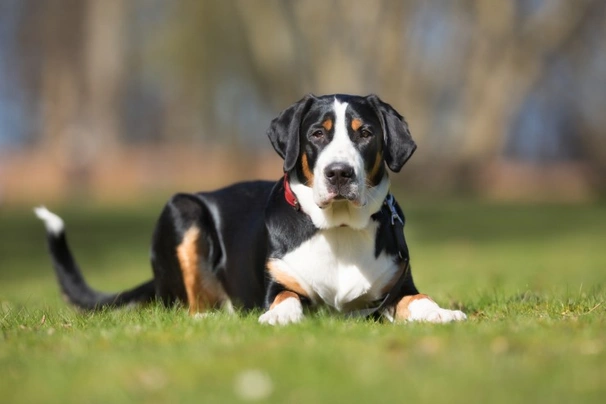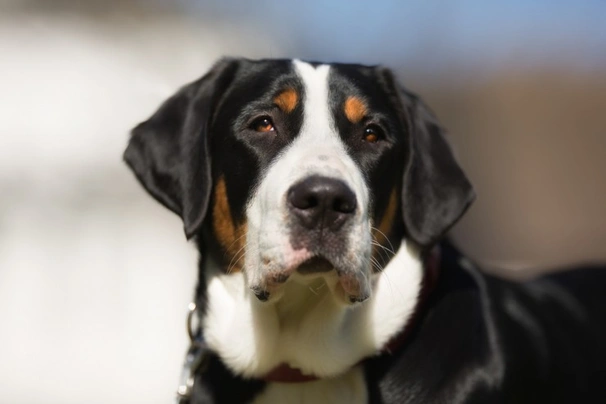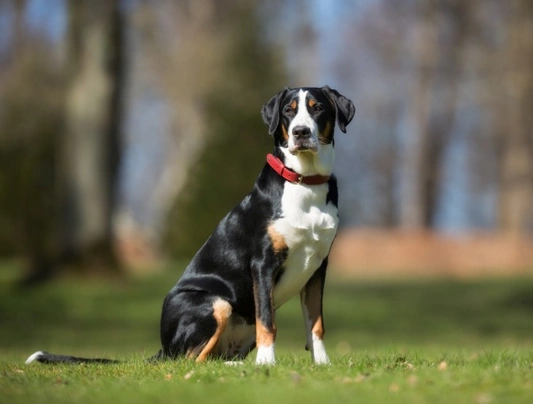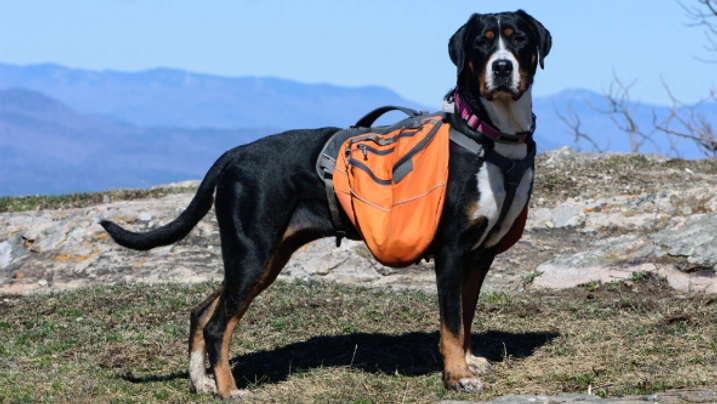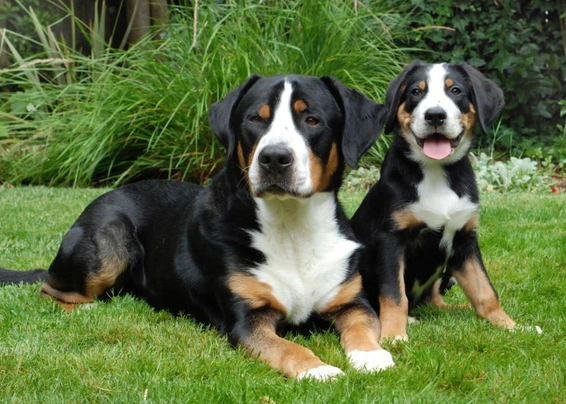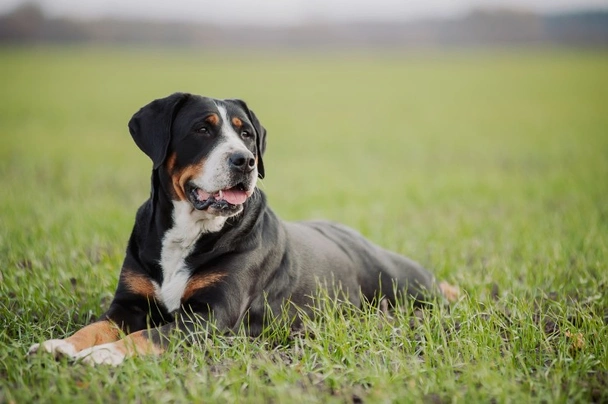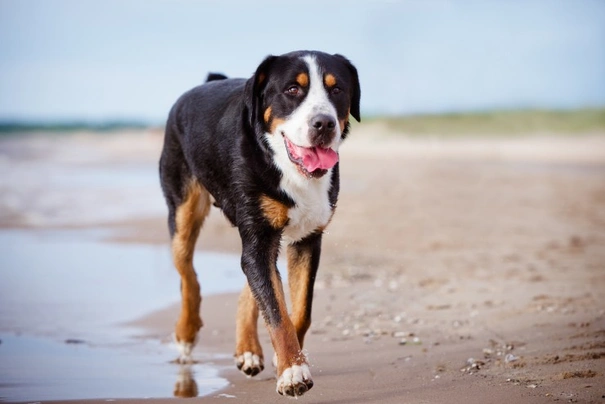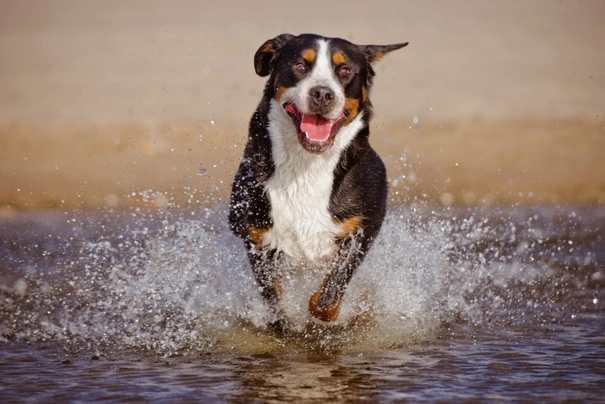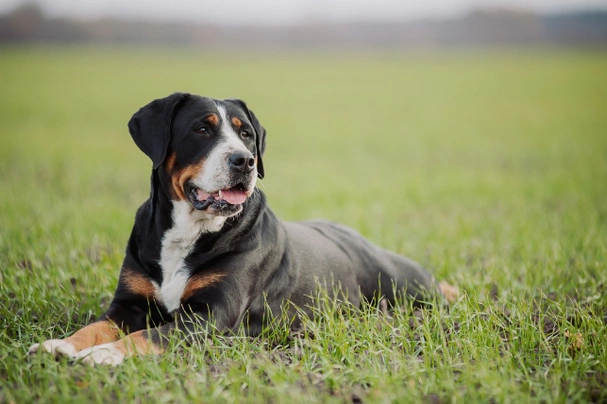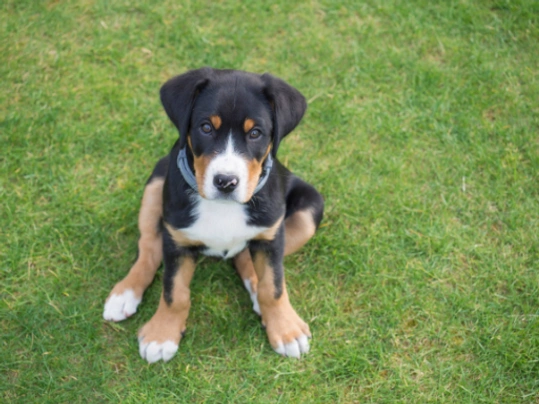Greater Swiss Mountain Dog
Pros
Cons
Introduction of the Greater Swiss Mountain Dog
The Greater Swiss Mountain Dog stands out as a majestic and powerful breed, boasting a distinctive tricolour coat that exudes strength and charm. Valued originally for their incredible working ability, Swissies today serve predominantly as loyal family companions, guardians, and versatile working dogs. Their calm, confident demeanour paired with a friendly yet protective temperament makes them uniquely suited to active households that can provide them with ample space and engagement.
These large dogs resemble the more commonly known Bernese Mountain Dog in colour but differentiate themselves with a shorter coat and a robust build that attests to their origins as alpine farm workers. Their trusting and devoted nature means they bond deeply with their families, including children, and relish being included in daily activities.
Ideal owners are those who appreciate the breed's need for regular exercise, mental stimulation, and a spacious living environment—often with a large secure garden. Due to their size and strength, they thrive best in homes where they are not confined too frequently. Training requires consistency and patience, but their high intelligence and eagerness to please reward owners with a well-mannered companion. Prospective owners should be ready for moderate grooming needs and the commitment that comes with owning such a dignified working breed.
Greater Swiss Mountain Dogs are an excellent choice for those looking for a dependable family guardian who also excels in canine sports and has a gentle playful side. Their rich history and ongoing popularity in the UK are reflected in the growing number of dedicated breeders providing healthy, well-socialised puppies that carry forward this noble legacy.
Perfect For
Families with ample space and an active lifestyle, working dog enthusiasts, first-time owners prepared for a large breed, and those seeking a devoted, protective companion.
Key Considerations
Requires consistent training and early socialisation, sensitive to being left alone for long periods, needs regular but not excessive grooming, and benefits greatly from secure, spacious outdoor access to thrive.
History of the Greater Swiss Mountain Dog
The Greater Swiss Mountain Dog traces its lineage back over 2,000 years, believed to descend from large mastiff-type dogs brought to the Swiss Alps by Roman legions. These dogs were crossed with indigenous herding breeds, culminating in a versatile and rugged working dog that thrived in alpine farm environments. It is one of four distinct Swiss mountain breeds, including the Bernese Mountain Dog and the Saint Bernard, distinguishable by their coat patterns and specific working roles.
Early Development
Historically, Swissies were bred to be multi-purpose dogs: herding cattle, guarding property, and pulling carts laden with goods across alpine terrain. Their strength and endurance earned them the nickname "the poor man's horse". The breed faced a decline in numbers until Franz Schertenlieb spearheaded a revival effort in the early 20th century, locating and exhibiting Swissies to wider audiences. His work was supported by Judge Dr Albert Heim who championed the breed to farmers and enthusiasts. During World War II, Greater Swiss Mountain Dogs served as reliable military dogs.
Modern Recognition
The breed was first officially recognised in Switzerland in 1910 under the name Grosse Schweizer Sennehund. In the UK, they were admitted into The Kennel Club's Working Group in 2008 with full registration by 2016, elevating their profile in show rings and among working dog communities. A dedicated breed club in the UK provides resources and promotes responsible breeding practices. Despite their growing popularity, the breed remains relatively rare and prized for their unique heritage and temperament worldwide.
Appearance of the Greater Swiss Mountain Dog
Size and Build
The Greater Swiss Mountain Dog is a large, muscular breed with males standing 65-72 cm at the withers and females slightly smaller at 60-68 cm. Weight ranges from 60-70 kg for males and 50-60 kg for females, reflecting a solid and powerful frame. Their overall structure is balanced and robust, with a broad chest, strong shoulders, and well-muscled limbs designed for endurance and strength in demanding environments.Coat and Colours
The breed’s short, dense double coat lies close to the body, providing protection against harsh weather without demanding excessive grooming. The classic tricolour pattern features a predominantly black base complemented by symmetrical rust-coloured markings and distinct white accents on the chest, muzzle, and legs. Unlike their Bernese Mountain Dog cousins, the GSMD’s shorter coat reduces grooming time while maintaining striking visual appeal.Distinctive Features
The head is strong and well-proportioned with a flat, broad skull and a square muzzle that is longer than deep. Almond-shaped hazel to dark brown eyes express alertness and kindness. The medium-sized triangular ears sit high and lie flat when relaxed but are mobile when the dog is attentive. A broad neck flows smoothly into strong shoulders and a level, well-muscled back. The tail is set level with the croup and hangs low at rest, rising during movement, contributing to their characteristic gait which displays good reach and drive.Gender Differences
Males are generally larger and more heavily muscled, whereas females present a refined yet equally powerful appearance. Temperamentally, males may display a slightly stronger protective instinct while females often exhibit increased maternal sensitivity and gentleness, though individual variation always applies. Both genders require ample physical and mental stimulation to maintain balanced behaviour.Faults that affect the breed’s health or ability to work are carefully penalised in show rings. While size may vary slightly beyond the standard range, well-bred Swissies exemplify strength, efficiency, and elegant movement.
Temperament of the Greater Swiss Mountain Dog
The Greater Swiss Mountain Dog embodies a calm, confident, and devoted temperament, making them exemplary companions for families seeking a reliable guardian. Their trustworthy and loyal nature fosters deep bonds with family members, including children, whom they treat with genuine gentleness despite their imposing size.
Highly intelligent and observant, Swissies are naturally alert to their environment and quick to notify owners of any unusual activity. Their self-assurance allows them to accept strangers peacefully, especially when their owner is present, reflecting their balanced guarding instincts without aggressive tendencies.
Social interactions generally are positive, with Swissies tending to get along well with other dogs and household pets when properly socialised from an early age, though their innate herding instincts may trigger chasing behaviours towards small animals which owners should carefully manage.
The breed’s playful and sometimes mischievous side emerges in relaxed environments, displaying a capacity for entertainment and bonding through games. However, they require sufficient mental challenges and daily exercise to prevent boredom and maintain a well-rounded temperament. Separation anxiety is uncommon if their social needs and exercise requirements are met, although prolonged loneliness can lead to destructive behaviours.
Core Personality Traits
Calm but alert, devoted, intelligent, gentle with children, and naturally protective without aggression.
Social Behaviour
Friendly and accepting of strangers when owners are present, generally good with other dogs and cats, cautious with smaller pets to avoid chasing.
Working Instincts
Strong herding and guarding drives, enjoys mental stimulation, expresses playfulness with a mischievous streak.
Common Behavioural Challenges
Potential for destructive behaviour if bored or left alone too long, requires early socialisation to mitigate chasing impulses, and may be stubborn without consistent training.
Intelligence / Trainability of the Greater Swiss Mountain Dog
Greater Swiss Mountain Dogs are renowned for their intelligence and eagerness to please, making them highly trainable when approached with patience and consistency. Early socialisation and training are crucial to develop their natural confidence and curb any emerging stubbornness, especially given their substantial size and strength.
Puppy Training Priorities
From the moment a Swissy puppy joins your home, focus on introducing them calmly and positively to various environments, people, and animals. This foundation not only fosters social adaptability but also prevents fear-based behaviours. Establish basic obedience commands early, including sit, stay, come, heel, quiet, leave it, down, and bed. Consistency in boundaries and clear communication help set the hierarchy and build mutual respect.Training Methods That Work
Positive reinforcement techniques are particularly effective with the GSMD, including treats, praise, and play. Sessions should be engaging yet brief to maintain motivation and prevent frustration. Avoid harsh corrections; instead, redirect unwanted behaviour with calm firmness. Incorporating mental stimulation through problem-solving games and obedience exercises keeps their keen mind active.Advanced Training Potential
The breed thrives in advanced obedience, drafting, carting, agility, and therapy work when given proper guidance. Their heritage as versatile working dogs enables them to excel in various canine sports that channel their strength and intelligence positively.Common Training Mistakes
Common pitfalls include inconsistent handling, lack of early socialisation, and allowing overly boisterous play to go unchecked in puppyhood. Over-exercising puppies can lead to joint problems; therefore, exercise should be balanced with rest during growth phases.With well-planned training and early intervention, the Greater Swiss Mountain Dog grows into a well-mannered, sociable, and obedient companion suitable for a variety of lifestyles.
Children and other
The Greater Swiss Mountain Dog is exceptionally well-suited to family life and generally displays a gentle, patient attitude towards children across all ages. Their calm nature allows them to coexist peacefully with toddlers, although supervision is essential to prevent accidental knocks due to their large size and exuberant play.
Older children and teenagers often form deep, interactive bonds with Swissies, appreciating their loyalty and willingness to engage in activities. Teaching children proper canine etiquette fosters safe and enjoyable shared experiences, including respecting the dog's personal space and understanding body language cues.
The breed tends to get along well with other family pets, including other dogs and cats, particularly if raised together from an early age. However, their natural herding instincts may prompt playful chasing or herding behaviours towards smaller animals, so vigilance is recommended when introducing new pets or in neighbourhood settings.
Creating a safe environment involves ensuring secure fencing in the garden, providing a quiet retreat for the dog, and supervising interactions especially during high energy times. Proper early socialisation, training, and positive reinforcement further enhance their family-friendly qualities, making the GSMD a truly affectionate and protective family member.
Health of the Greater Swiss Mountain Dog
The Greater Swiss Mountain Dog has a life expectancy generally ranging from 10 to 11 years, although individual longevity can vary based on genetics and care. The breed is predisposed to a handful of hereditary health conditions that responsible breeders and owners should be aware of.
Breed-Specific Health Conditions
DSwissies may suffer from bloat (gastric dilatation-volvulus), a life-threatening condition requiring immediate veterinary attention. Splenic torsion, although less common, is also associated with this syndrome. Additionally, epilepsy presents as a chronic neurological condition in a minority of dogs. Orthopedic issues such as hip and elbow dysplasia, while less prevalent than in some large breeds, still warrant screening and consideration. Osteochondritis dissecans (OCD), eye problems, and cancer are also noted concerns.
Genetic Testing Requirements
It is strongly advised that all breeding stock be screened through the BVA or Animal Health Trust for hip and elbow dysplasia to ensure skeletal soundness. Eye health testing is recommended biennially. While no breed-specific genetic tests exist for all conditions, evaluation and documentation of clinical health history are critical for screening.
Preventive Healthcare Schedule
Swissy puppies typically begin vaccinations at 10-12 weeks with follow-up boosters ensuring protection. Many vets advocate for spaying and neutering between 6 to 12 months of age while considering the dog’s individual development. Regular worming and flea control following veterinary guidance is imperative for ongoing health maintenance.
Insurance Considerations
Due to their size and potential for hereditary conditions, insurance premiums are higher than average for the breed. Comprehensive lifetime cover is recommended to offset costs of potential surgeries and chronic condition management. Owners should review coverage specifics related to bloat, epilepsy, and orthopedic treatments.
Caring for the Greater Swiss Mountain Dog
Caring for a Greater Swiss Mountain Dog requires a balance of regular grooming, consistent exercise, and attentive health monitoring. Their short dense coat needs weekly brushing to maintain skin health and remove loose hairs, especially during shedding seasons in spring and autumn when grooming frequency should increase.
Daily exercise—typically about one hour—is essential to maintain their muscular build and mental well-being. Outdoor access in a securely fenced garden provides them freedom to move safely. Puppies require special care to prevent joint strain; exercise should be gentle and non-strenuous until full maturity around 2 years of age.
Additionally, puppies benefit from a calm indoor environment with puppy-proofing measures to prevent accidents and destructive exploration. Setting up a quiet sleeping area allows for proper rest and growth. Feeding routines should follow breeder or veterinary guidance, including scheduled worming and vaccinations.
Senior Swissies need adapted care addressing common age-related changes such as reduced mobility, temperature regulation, and dietary needs. Providing orthopedic bedding, moderated exercise, and regular veterinary check-ups ensures a comfortable and dignified older life.
Grooming of the Greater Swiss Mountain Dog
The Greater Swiss Mountain Dog's grooming regime is relatively low-maintenance compared to many large breeds, thanks to its short, dense double coat. A thorough weekly brushing session using tools such as slicker brushes or rubber curry combs suffices to keep the coat healthy, shiny, and free from tangles.
During seasonal shedding in spring and autumn, increased brushing frequency helps manage the loose undercoat and reduces hair around the home. Bathing is recommended as needed using dog-specific shampoos to preserve skin moisture and avoid irritation. Particular attention should be paid to ear hygiene, cleaning regularly to prevent infections commonly seen in floppy-eared breeds.
Nail trimming is essential and should be started early in puppyhood, incorporating positive reinforcement to ease stress associated with the procedure. Dental care through regular brushing supports overall health, preventing periodontal disease.
Common grooming challenges include managing shedding during peak seasons and monitoring skin and ear health. Early training to grooming routines fosters cooperation and easier maintenance throughout the dog’s life.
Exercise of the Greater Swiss Mountain Dog
Greater Swiss Mountain Dogs require a moderate to high level of exercise to maintain optimal health and happiness. Adults need about 60 to 90 minutes of physical activity daily, ideally split into multiple sessions such as a morning walk complemented by a longer, more stimulating walk or play session in the afternoon. This regimen supports their robust build and working heritage.
While puppies are naturally energetic, exercise should be carefully moderated to protect developing joints, avoiding strenuous activity, rough play, and excessive stair climbing until around two years old. Gentler activities such as controlled play and short, calm walks benefit young Swissies.
Breed-appropriate activities for adults include hiking, swimming, carting (draft work), weight pulling, and obedience training, leveraging their intelligence and strength. Mental stimulation alongside physical exercise is vital to prevent boredom-driven behaviours. Exercise should always be adapted during hot weather, providing cooler times of day to avoid heat stress.
Mental enrichment can include puzzle toys, scent tracking games, and obedience challenges to keep their keen minds engaged.
Feeding of the Greater Swiss Mountain Dog
Feeding the Greater Swiss Mountain Dog requires attention to quality, quantity, and frequency, tailored to the different life stages of puppies and adults. Puppies require small, frequent meals—generally three to four times daily—to support rapid growth while minimizing digestive disturbances.
High-quality commercial diets designed for large breeds or balanced homemade meals rich in animal proteins, fats, and essential nutrients are recommended. Portion sizes should be monitored carefully to prevent overfeeding and associated obesity, a concern in large breeds that can exacerbate joint issues.
Transition to adult dog food typically occurs around 18 months of age once growth stabilises. Adult Swissies do well with two meals per day to reduce the risk of bloat, a notable health concern for the breed. Using raised feeding stations can aid comfortable eating and digestion.
Supplementation, such as glucosamine and chondroitin, is often advised to promote joint health, especially for older dogs or those exhibiting signs of orthopedic strain. Treats should be healthy and given in moderation to maintain ideal body condition.
Consistent feeding routines paired with appropriate exercise regimes help maintain a healthy waistline lifelong.
Greater Swiss Mountain Dog price
Purchasing a Greater Swiss Mountain Dog puppy from a reputable, ethical breeder in the UK typically ranges from £800 to £1,500, reflecting the breed's rarity and breeding standards. Delays in availability mean prospective owners often register interest well in advance to secure a well-bred puppy.
Initial setup costs for a Swissy puppy include essentials such as quality crates, collars, leads, grooming tools, and suitable bedding, which can amount to approximately £250 to £400 depending on preferences and brand choices.
Ongoing monthly expenses comprise quality dog food (£60-£70), routine grooming items, and veterinary care including vaccinations, flea and worm treatments, and annual health checks. Insurance premiums vary, with basic coverage averaging £60-£70 per month and comprehensive lifetime policies potentially exceeding £110 monthly.
Owners should budget for unexpected veterinary bills and the increased healthcare needs of senior dogs. On average, the total cost of ownership may range between £130 to £190 monthly, excluding the initial purchase price.
For those interested, you can find Greater Swiss Mountain Dog for sale on Pets4Homes, where a selection of both registered and family companion puppies may become available.
Buying advice
Prospective owners looking to bring a Greater Swiss Mountain Dog into their family should prepare for the breed's specific needs and responsibilities. Securing a healthy, well-bred puppy requires patience and diligence in selecting a reputable breeder.
Ethical breeders provide transparent access to health screening records, including hip and elbow dysplasia results validated by BVA or the Animal Health Trust, and eye testing to prevent hereditary issues. They welcome visits to the breeding environment, where puppies are socialized in a home setting, ensuring well-adjusted temperaments on arrival.
Beware of scams—never purchase a puppy unseen or pay deposits without vetting the breeder thoroughly. Responsible breeders limit the number of litters a dam produces and stand by their puppies with contracts offering health guarantees and lifelong support. Additionally, research breed-specific rescues as an alternative avenue to provide a home to a deserving dog.
As the Greater Swiss Mountain Dog grows in UK popularity, prices for a quality pedigree puppy range from £800 to £1,500. Proper budgeting should also include health care, insurance, and ongoing care expenses. For verified listings, you can find Greater Swiss Mountain Dog for sale on Pets4Homes.
Finding Ethical Breeders
Look for breeders affiliated with the Greater Swiss Mountain Dog Club or recognised working dog organisations, ensuring compliance with breed standards and health testing.
Health Testing Verification
Confirm all relevant health clearances, including hip and elbow scoring and eye examinations, before purchase.
Puppy Selection Process
Evaluate temperament, ask to meet parents if possible, and observe the living conditions of puppies.
Contract and Guarantee Review
Always review sales contracts carefully for clauses covering health guarantees, return policies, and microchipping.
Rescue and Adoption Options
Explore breed-specific rescue organisations and adoption procedures for those open to giving a Swissy a second chance at a loving home.
